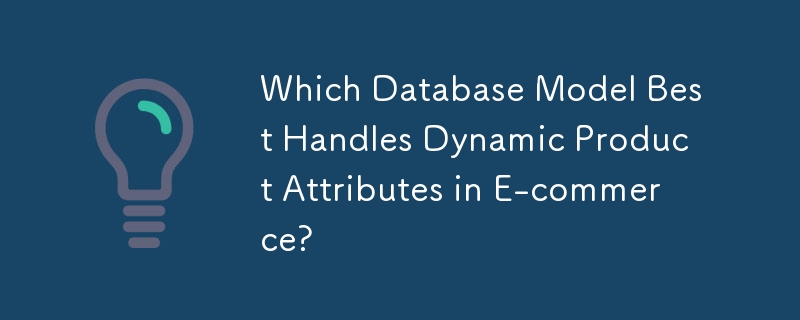 Database
Database
 Mysql Tutorial
Mysql Tutorial
 Which Database Model Best Handles Dynamic Product Attributes in E-commerce?
Which Database Model Best Handles Dynamic Product Attributes in E-commerce?
Which Database Model Best Handles Dynamic Product Attributes in E-commerce?

E-commerce Product Attributes: Database Modeling Strategies
Efficiently managing product attributes is crucial for successful e-commerce. The challenge lies in handling dynamic attributes—those that can be added or modified on the fly. Choosing the right database model is key.
Why EAV Isn't the Answer
The Entity-Attribute-Value (EAV) model, while seemingly flexible, presents significant drawbacks for e-commerce. Its lack of data type enforcement and reliance on complex queries lead to performance bottlenecks and scalability issues.
Superior Alternatives for E-commerce
For robust e-commerce attribute management, consider these alternatives:
1. Relational Modeling with Attribute Grouping:
Structure your database with separate tables for each product category, defining attributes within each table. This ensures data integrity, simplifies querying, and improves reporting.
2. Hybrid Approach: Relational Core with Extensibility:
Utilize entity-specific tables as the foundation, supplementing them with an "extension" table for custom attributes. This balances the strengths of relational modeling with the ability to add new attributes as needed.
Choosing the Right Model
The ideal database model depends on several factors: data volume, query complexity, and the anticipated frequency of attribute changes. For large datasets and intricate queries, a relational model is generally the better choice. If flexibility and adaptability are paramount, a hybrid approach might be more suitable.
Key Takeaway
Effective management of dynamic product attributes in e-commerce demands careful database design. By avoiding the pitfalls of EAV and leveraging the advantages of relational or hybrid models, businesses can create a robust infrastructure for efficient product data management, ultimately enhancing the customer experience and driving business growth.
The above is the detailed content of Which Database Model Best Handles Dynamic Product Attributes in E-commerce?. For more information, please follow other related articles on the PHP Chinese website!

Hot AI Tools

Undresser.AI Undress
AI-powered app for creating realistic nude photos

AI Clothes Remover
Online AI tool for removing clothes from photos.

Undress AI Tool
Undress images for free

Clothoff.io
AI clothes remover

AI Hentai Generator
Generate AI Hentai for free.

Hot Article

Hot Tools

Notepad++7.3.1
Easy-to-use and free code editor

SublimeText3 Chinese version
Chinese version, very easy to use

Zend Studio 13.0.1
Powerful PHP integrated development environment

Dreamweaver CS6
Visual web development tools

SublimeText3 Mac version
God-level code editing software (SublimeText3)

Hot Topics
 1378
1378
 52
52
 How do you alter a table in MySQL using the ALTER TABLE statement?
Mar 19, 2025 pm 03:51 PM
How do you alter a table in MySQL using the ALTER TABLE statement?
Mar 19, 2025 pm 03:51 PM
The article discusses using MySQL's ALTER TABLE statement to modify tables, including adding/dropping columns, renaming tables/columns, and changing column data types.
 Explain InnoDB Full-Text Search capabilities.
Apr 02, 2025 pm 06:09 PM
Explain InnoDB Full-Text Search capabilities.
Apr 02, 2025 pm 06:09 PM
InnoDB's full-text search capabilities are very powerful, which can significantly improve database query efficiency and ability to process large amounts of text data. 1) InnoDB implements full-text search through inverted indexing, supporting basic and advanced search queries. 2) Use MATCH and AGAINST keywords to search, support Boolean mode and phrase search. 3) Optimization methods include using word segmentation technology, periodic rebuilding of indexes and adjusting cache size to improve performance and accuracy.
 How do I configure SSL/TLS encryption for MySQL connections?
Mar 18, 2025 pm 12:01 PM
How do I configure SSL/TLS encryption for MySQL connections?
Mar 18, 2025 pm 12:01 PM
Article discusses configuring SSL/TLS encryption for MySQL, including certificate generation and verification. Main issue is using self-signed certificates' security implications.[Character count: 159]
 What are some popular MySQL GUI tools (e.g., MySQL Workbench, phpMyAdmin)?
Mar 21, 2025 pm 06:28 PM
What are some popular MySQL GUI tools (e.g., MySQL Workbench, phpMyAdmin)?
Mar 21, 2025 pm 06:28 PM
Article discusses popular MySQL GUI tools like MySQL Workbench and phpMyAdmin, comparing their features and suitability for beginners and advanced users.[159 characters]
 How do you handle large datasets in MySQL?
Mar 21, 2025 pm 12:15 PM
How do you handle large datasets in MySQL?
Mar 21, 2025 pm 12:15 PM
Article discusses strategies for handling large datasets in MySQL, including partitioning, sharding, indexing, and query optimization.
 How do you drop a table in MySQL using the DROP TABLE statement?
Mar 19, 2025 pm 03:52 PM
How do you drop a table in MySQL using the DROP TABLE statement?
Mar 19, 2025 pm 03:52 PM
The article discusses dropping tables in MySQL using the DROP TABLE statement, emphasizing precautions and risks. It highlights that the action is irreversible without backups, detailing recovery methods and potential production environment hazards.
 Difference between clustered index and non-clustered index (secondary index) in InnoDB.
Apr 02, 2025 pm 06:25 PM
Difference between clustered index and non-clustered index (secondary index) in InnoDB.
Apr 02, 2025 pm 06:25 PM
The difference between clustered index and non-clustered index is: 1. Clustered index stores data rows in the index structure, which is suitable for querying by primary key and range. 2. The non-clustered index stores index key values and pointers to data rows, and is suitable for non-primary key column queries.
 How do you create indexes on JSON columns?
Mar 21, 2025 pm 12:13 PM
How do you create indexes on JSON columns?
Mar 21, 2025 pm 12:13 PM
The article discusses creating indexes on JSON columns in various databases like PostgreSQL, MySQL, and MongoDB to enhance query performance. It explains the syntax and benefits of indexing specific JSON paths, and lists supported database systems.




